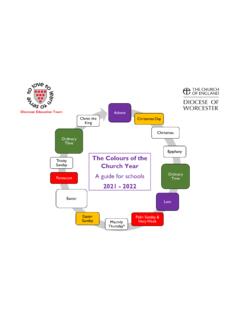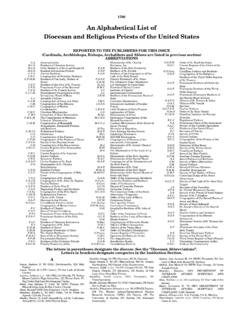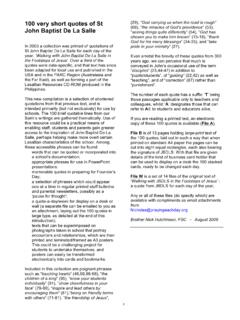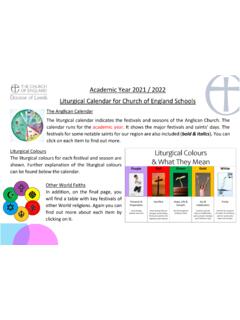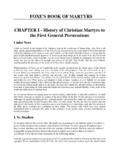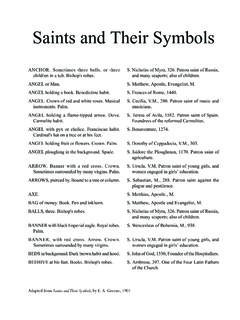Transcription of Divine Mercy in My Soul
1 Divine Mercy In my soul Preface The diary of Sister Maria faustina H. Kowalska is the record of her life experience the journey of her soul. She was graces by a special communion with God, and the diary expresses her conviction that this communion ought to be the center of our lives. Since the 1940 s the Marians of the Immaculate Conception, St. Stanislaus Kostka Province, have shared this conviction and have undertaken the promulgation of God s Mercy throughout the world, particularly as it has been proclaimed by Sister faustina .
2 In 1979, convinced of the importance of the diary, the Marians were instrumental in bringing it in its rough typewritten form out of Poland. We made the necessary corrections to the manuscript and published a critical Polish edition that has been promulgated throughout the world to Polish speaking people. At the same time, we commissioned a couple in Poland, Adam and Danuta Pasicki, to translate the diary into English. Once they had completed this first, literal translation, we asked Archbishop George Pearce, , to re-translate portions of it in accordance with proper English terminology for the various theological concepts and spiritual experiences referred to throughout the diary.
3 Archbishop Pearce was supported in this second translation by Fahters George Kosicki, , Gerald Farrel, , Leo McCauley, , and an Oblate, Francis Baga, When this text was completed, it was given to Father Seraphim Michalenko, , who was Director of the Divine Mercy Department from 1979-1986. Together with Sister Sophia Michalenko, , he carefully reviewed the translation, often referring back to the original Polish to ensure exactness of expression. Father Joseph Sielski, and Father Kazimierz, , were then asked to review the text, re-reading it for authentic agreement with the Polish.
4 Finally, in the first part of 1987, the text was returned to the Divine Mercy Department, now headed by Father George Kosicki, through his efforts, the tireless work of Sister Sophia Michalenko, , and the assistance of Vincent Flynn, the diary was subjected to a complete editing, re-typing, and proofing process for clarity of expression and readability according to current English grammar and usage. The index, listing the main themes of the diary, was compiled by Father Eugene Ozimek and developed by Fr. George Kosicki and Sister Sophia.
5 The design, composition, and mechanicals were then completed by Charles Parise and Pat Menatti, and the diary was printed by the Marian Press at the Marian helpers center. To all involved with this work, we wish to express our deepest gratitude and the assurance of our prayers. Since the Polish diary is the official text, we have made every effort to be truly faithful to it, and to retain the various shades of meaning implied in the theological and spiritual terms used by Sister faustina a definite challenge, indeed!
6 In translating the diary, we dealt with the same kind of challenge that faces the translators of Sacred Scripture. Some terms allow for a variety of expressions even though the meanings are the same, and the final translation thus becomes a personal choice of style and expression on the part of the translator. For the most part, the texts that have already been published in the popular devotional booklets are the same as those used in the diary, though in some instances, there again may be slight differences of style and expression.
7 Special Features of this New English Edition In the final editing process, inconsistencies of verb tense, capitalization, and punctuation were standardized as much as possible without losing Sister faustina s unique style and powerful simplicity of expression. Our Lord s words to Sister faustina were set in Bold Type (We, Sue and Marianne, Put Our Lord s words in Red, Our Lady s in Blue, and Angels in Purple) for emphasis, while Our Lady s words were set in Italics. The page numbers of Sister faustina s original notebooks were also set in bold type, and paragraphs thought to be overly long or diversified in content were split into shorter paragraph units for readability.
8 The footnotes too, have been reexamined, and additional clarifying notes have been added where necessary. Notes that were no longer pertinent, in light of changes incorporated into the English translation, were deleted; and, wherever possible, explanatory notes were placed in [square brackets] in the text itself to avoid unnecessary breaks in the reading. Our deepest hope is that this diary may truly be a vehicle of grace for all who read it, for in reading it we can see that the Mercy of God lives forever. Above all, we hope that all people will be struck by the truth that mankind will not have peace until it turns with trust to God s Mercy .
9 May each one of you experience the power of the Blood and Water that poured out from the Heart of Jesus as a fount of Mercy , and may each of you find confidence and trust in this ever present Mercy of God! Gratefully in the Lord, Very Rev. Richard J. Drabik, Provincial Superior Eden Hill, Stockbridge, Massachusetts March 19, 1987. ORIGINAL PREFACE TO THE POLISH EDITION, 1981 In presenting this edition of the Diary of Sister faustina Kowalska I am fully aware that I am introducing a document of Catholic mysticism of exceptional worth, not only for the church in Poland, but also for the Universal church .
10 This publication is the critical edition, and thus reliable. It is the work of the Postulator of Sister faustina , under the direction of the authority of the Archdiocese of Cracow. The Diary, whose object is devotion to the Divine Mercy , has acquired tremendous interest lately for two reasons: Firstly: the Sacred Congregation for the Doctrine of the Faith, in its revision more then two years ago [1978], withdrew the consures and reservations advanced earlier by the Holy See in relation to the writings of Sister faustina .
